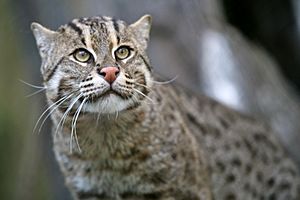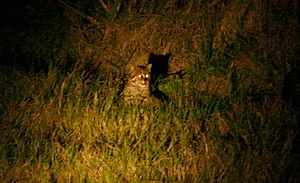Fishing cat facts for kids
Quick facts for kids Fishing Cat |
|
|---|---|
 |
|
| Conservation status | |
| Scientific classification | |
| Kingdom: | |
| Phylum: | |
| Class: | |
| Order: | |
| Family: | |
| Genus: | |
| Species: |
Prionailurus viverrinus
|
The fishing cat (Prionailurus viverrinus) is a wild cat found in parts of South Asia and Southeast Asia. It's a medium-sized cat, about twice as big as a regular house cat. Fishing cats are strong and muscular, with shorter legs.
In 2008, the IUCN listed the fishing cat as Endangered. This means their numbers are dropping quickly. They live in wetland areas like swamps and marshes. Sadly, these homes are shrinking because of human activity.
Fishing cats are amazing swimmers, just like their close relative, the leopard cat. They love living near rivers, streams, and mangrove swamps. Their feet are partly webbed, which helps them catch fish!
Contents
What Does a Fishing Cat Look Like?

The fishing cat is the largest type of Prionailurus cat. Its fur is usually olive-grey to ashy-grey. It has darker stripes on its shoulders and round spots on its sides.
Its ears are short and rounded, set low on its head. The back of each ear has a white spot, which looks a bit like an eye. It also has two stripes on its cheeks and four stripes running from its eyes to its shoulders. Its belly is white, with two rows of spots around its throat.
The tail is short, less than half the length of its body. It has spots near the base and a few black rings at the end. An adult fishing cat is about 57 to 78 cm (22 to 31 in) long, not including its tail. Its tail adds another 20 to 30 cm (7.9 to 11.8 in). These cats can weigh from 5 to 16 kg (11 to 35 lb).
Their paws are partly webbed, which is perfect for their watery lifestyle. Their claws don't fully retract, so they stick out a little even when pulled back.
Where Do Fishing Cats Live?
Fishing cats are found in different parts of Asia, but not everywhere. You can find them in the Terai region near the Himalayan mountains in India and Nepal. They also live in eastern India, Bangladesh, and Sri Lanka.
There haven't been many confirmed sightings in Peninsular Malaysia, Vietnam, or Laos. In India, they've been seen in places like Ranthambhore Tiger Reserve and Coringa Wildlife Sanctuary.
They've also been spotted along the coast in Thailand. In Cambodia, a fishing cat kitten was found in Botum-Sakor National Park in 2008. In 2012, one was even recorded in Sindh Province, Pakistan.
Newspapers in Bangladesh report that fishing cats live in all parts of the country. However, they are seriously threatened there. Villagers sadly killed many fishing cats between 2010 and 2013.
The island of Java is the southernmost place where fishing cats live. But by the 1990s, they were rare there. They mostly lived in tidal forests, mangrove areas, and old fishponds.
Fishing cats love wetlands. They usually live in swamps, marshy areas, and mangrove forests. They don't seem to like smaller, fast-moving rivers as much. Most records show them living in lowland areas. Even though they can live in different types of forests, they tend to stay in very specific spots.
How Do Fishing Cats Live?
Fishing cats are mostly active at night. Adult males and females usually live alone, unless a female has young kittens. They are very comfortable in water and can swim long distances, even underwater!
Female fishing cats might roam over an area of 4 to 6 km2 (1.5 to 2.3 sq mi). Males, however, cover much larger areas, about 16 to 22 km2 (6.2 to 8.5 sq mi). Adult fishing cats have been heard making a "chuckling" sound.
These cats hunt along the edges of water. They grab prey from the water or even dive in to catch fish further from the banks. Their main food is fish. Studies in India showed that fish make up about three-quarters of their diet. They also eat birds, insects, and small rodents. Sometimes, they'll eat Molluscs, reptiles (like snakes), amphibians, and even dead farm animals.
Fishing cats mark their territory by rubbing their cheeks, heads, chins, and necks on things. They also spray urine to leave their scent marks. They sharpen their claws and sometimes show a special face called a flehmen behavior.
Images for kids
-
Fishing cat at the Cincinnati Zoo
See also
 In Spanish: Gato pescador para niños
In Spanish: Gato pescador para niños








